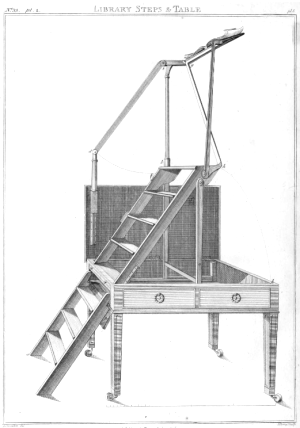
In the 18th century wealthy men with private libraries in their grand houses wanted elegant furniture around them. The upmarket cabinet-makers of the period created fine desks and chairs, but how could they design new, improved versions of the step-ladders needed for reaching books from the highest shelves?
One idea was to conceal steps under the seat of a long stool. Turned upright, its upholstered seat to the wall, it made a short ladder with three treads, each smaller than than the last: perhaps not a very stable arrangement. It is rare to find any of these on the antiques market, and it is unlikely that many were made, as better furniture soon followed.
Chippendale designed the kind described above in the 1750s, but in the next decade he created hinged steps that could be folded into a stool. This type can be seen at Harewood House and Nostell Priory in England. One was described at the time as a “large mahogany library stool with the seat to rise as a step ladder the seat stuff’d and cover’d with black leather”. (Nostell Priory accounts 1767) The other was given a neo-classical look with rosewood veneer and marquetry.
Benjamin Franklin had something better than a stool: a leather-upholstered chair with steps beneath. There are claims that his seat was the first ever chair and steps combination. Whether or not this is true, it is comfortable enough to be a real reader’s chair: ideal for someone who loves books as well as good furniture.
Tables were part of this new wave of convertible library furniture, and a British patent for a dual-function table with steps was registered in 1774. Sheraton published a design for one of these library tables before the end of the century. (Picture above)
This design was taken from steps that have been made by Mr. Campbell, Upholsterer to the Prince of Wales. They were first made for the King, and highly approved of by him, as every way answering the intended purpose. There are other kinds of library steps which I have seen, made by other persons, but, in my opinion, these must have the decided preference, both as to simplicity and firmness when they are set up. The steps may be put up in half a minute, and the whole may be taken down and enclosed within the table frame in about the same time.
Thomas Sheraton, The cabinet-maker and upholsterer’s drawing-book, London, 1802 edition

The name metamorphic (shape-changing) was not used for the earliest pieces of library furniture, but appeared in a London patent of 1811. The first ever “patent metamorphic library chair” with curving arms spawned many varied chair designs, some quite plain, others very elaborate. Georgian or Regency pieces of dual-purpose library furniture can fetch thousands of dollars at antiques auctions, and even later Victorian metamorphic chairs may be quite valuable.
One 19th century curiosity is based on a library staircase design that was boxed in at the sides. One stair-tread was a hinged lid giving access to storage beneath. This was adopted as bedroom furniture and used in some homes as a commode to conceal the chamber pot for night-time use.
Note
Since I first wrote this short piece for another website, Clive Taylor has published a fascinating, detailed, and original dissertation on The Regency Period Metamorphic Library Chair.